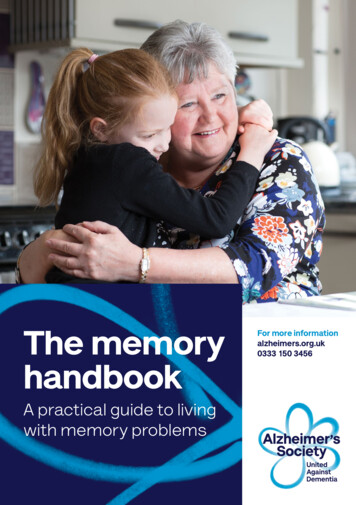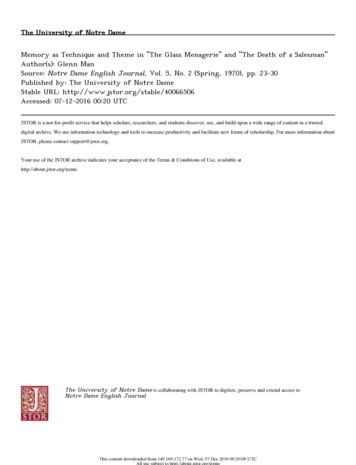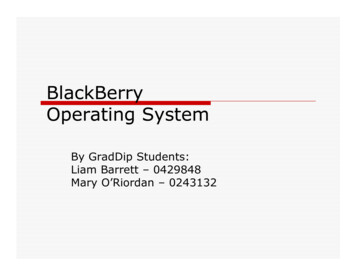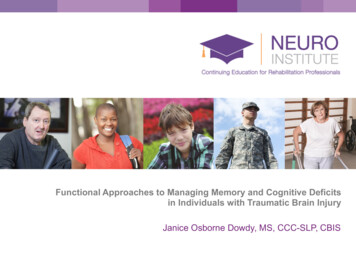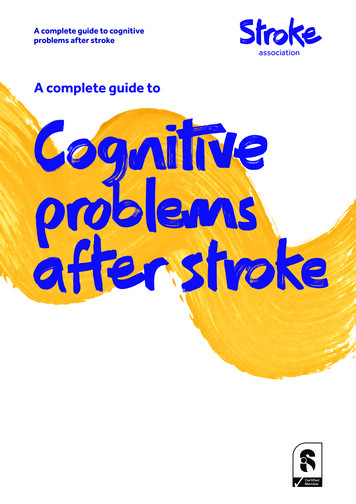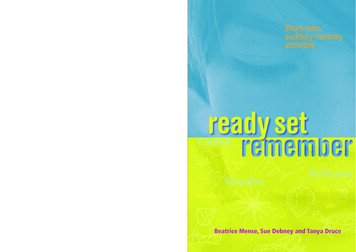
Transcription
ISBN 0-86431-468-XSue Debneyis a speech pathologist withover 25 years experienceworking with children in arange of settings includingcommunity health centres,schools, hospitals, Ready SetLearn and private practice.She has a Masters degree ineducational studies. Sue has astrong interest in the areas ofauditory processing, literacyacquisition and languagerelated learning disabilities.Tanya Drucehas worked in paediatricspeech pathology for over20 years at the Royal Children’sHospital, Melbourne, atReady Set Learn and in privatepractice. She has a graduatediploma in neurosciences.Tanya believes that fun,engaging activities to practiceauditory memory strategies areeffective in managing shortterm auditory memory delays.Short-term auditory memory activities Mense, Debney & DruceBeatrice Mensehas taught across a rangeof educational settings forover 30 years, from pre-schoolto secondary school anduniversity. She has a Mastersdegree in educational studies.Beatrice sees many childreneach week in a private literacyclinic and is an involvedmember of the Ready Set Learnteam, providing support tostaff and parents.ready set rememberReady Set Remember is a rich resource of information and activities for teachers with students whomay have auditory processing difficulties. In order to listen well, a child must have adequate hearing, intactauditory processing skills and an ‘active listening’ mindset.This book helps teachers identify children with auditory difficulties in the age range 5–8, before referringthem to an appropriate health professional. When the child returns to the classroom, Ready Set Rememberthen provides strategies and activities to encourage children’s confidence and improve their ability to efficientlyand effectively remember auditory information by practising listening and sequencing tasks.Section 1 of Ready Set Remember includes an introduction to hearing, auditory processing, activelistening, short-term auditory memory and their impact on successful classroom listening. The factors affectinga child’s ability to remember, and relationships between listening, auditory memory and literacy are alsoconsidered.Section 2 and 3 have over 30 activities and accompanying support materials, which have been usedsuccessfully by the authors over the past 20 years.Short-termauditory memoryactivitiesready setChunkturtleVisualisestrawberry780864 314680dogteddy bearstarpencils9RehearsefishBeatrice Mense, Sue Debney and Tanya Druce
ready setrememberShort-termauditory memoryactivitiesBEAT RI CE M ENSE , S U E D E BN E Y A N D TA N YA D RUC EACER Pressrsr prelim-section 1.indd i22/2/06 12:56:29 PM
First published 2006by ACER PressAustralian Council for Educational Research Ltd19 Prospect Hill Road, Camberwell,Victoria 3124Copyright 2006 Mense, Debney and DruceAll rights reserved. Except under the conditions described in the Copyright Act 1968 ofAustralia and subsequent amendments, no part of this publication may be reproduced,stored in a retrieval system or transmitted in any form or by any means, electronic, mechanical,photocopying, recording or otherwise, without the written permission of the publishers.Copying of the blackline master pagesThe purchasing educational institution and its staff are permitted to make copies of thepages marked as blackline master pages, beyond their rights under the Act, provided that:1 the number of copies does not exceed the number reasonably required by theeducational institution to satisfy its teaching purposes;2 copies are made only by reprographic means (photocopying), not by electronic/digitalmeans, and not stored or transmitted;3 copies are not sold or lent; and4 every copy made clearly shows the footnote (‘Copyright 2006 Mense, Debney and Druce’).For those pages not marked as blackline master pages the normal copying limits in the Act,as described above, apply.Edited by Anne FindlayCover and text design by Mason DesignTypeset by Mason DesignPrinted by Shannon BooksNational Library of Australia Cataloguing-in-Publication data:Mense, Beatrice Ruby.Ready set remember.Bibliography.Includes index.ISBN 0 86431 468 X.1. Hearing. 2. Listening. 3. Short-term memory.4. Word deafness in children. I. Debney, Sue Joy.II. Druce, Tanya Maree. III. Title.152.15Visit our website: www.acerpress.com.aursr prelim-section 1.indd ii22/2/06 12:56:30 PM
ContentsAbout the bookForewordivvSECTION 1 – CLASSROOM LISTENING AND REMEMBERINGIntroduction13Short-term auditory memory4Relationships between short-term auditory memory, listening and literacyStrategies to support short-term auditory memory in the classroomSECTION 2 – READY SET REMEMBER ACTIVITIESHow to use the activitiesList of activities171923SECTION 3 – BLACK LINE MASTER SUPPORT MATERIALSActivity picture and word cardsReproducible postersActivities index1022Activity outlines 1–33References99395133142143iiirsr prelim-section 1.indd iii22/2/06 12:56:30 PM
About the bookThis book aims to: support teachers, parents and others in their understanding of short-term auditorymemory and its importance in children’s learning and behaviour; promote an understanding of the classroom implications of short-term auditorymemory delay; supply resources for careful structured observation of children’s performance onshort-term auditory memory tasks; and improve active listening skills for all the children in the class, not only those withshort-term auditory memory difficulties.The book does not aim to ‘cure’ short-term auditory memory difficulties, rather toteach active strategies to work within the auditory memory capacity for each child.Ready Set Remember provides games and activities for classroom and small groupuse.The activities are written for children from Prep–Grade 2, but can be adapted foruse with younger children as well as older children with learning disabilities.We have written the activities for classroom teachers, but they could be easilyadapted for individual use by speech pathologists, audiologists, educational psychologists or special education teachers and others working with children in a 1:1learning situation.ConventionsIn this book the child is referred to as ‘he’ and the leader as ‘she’. The sample evaluationsheets give hypothetical responses from both males and females.ivrsr prelim-section 1.indd iv22/2/06 12:56:30 PM
ForewordListening skills, processing auditory information and remembering what has been saidare all central to learning in a classroom environment. Children do gradually improvein their ability to process auditory information throughout childhood and into adolescence, but it has become increasingly clear for those of us who work with childrenwho are struggling to achieve basic literacy skills that a delay in this development isvery commonly associated. It is crucial for those who teach children to be aware ofwhat is ‘normal’ and adjust our communication appropriately. It is certainly not a caseof ‘more is better’.For children who are developing this skill at a normal rate, or for those who aredelayed, other factors can play a part so that they are not functioning at their optimum level. When any of us cannot hear clearly because of noise, do not understandthe language or the terminology, or are distressed, inattentive or bored, we often stoplistening. If there is little return for the effort of listening, then it is easy to ‘switch off ’.Some of our children in classrooms have been described as bobbing up and down ina sea of ‘Blah blah blah’ and only coming up for air when there is the odd wordof interest. In our current society with the focus on visual learning and informationoverload, there is a tendency to not listen and to not train ourselves or our childrento listen.This book has some very useful observations of children’s listening behaviour withexplanations and implications for learning. The exercises and strategies are also veryhelpful for teaching children how to optimise their listening skills and these learningstrategies are then transferable to other areas of learning.The vast experience of the authors in observing, working with and assisting children with language and listening difficulties is clear from the materials presented.This book will be a very helpful resource for teachers to use in the important task ofgiving children strategies for learning and listening. Children who have difficulties inthese areas often need to have these strategies taught explicitly. They do not usuallylearn these strategies intuitively, as is evident by the large numbers of children comingto health professionals with behavioural difficulties often secondary to their failure toacquire adequate literacy skills. Using a combination of good pedagogical practice thattakes into account the development of auditory processing skills, and these strategiesto optimise listening skills in a classroom setting, hopefully health professionals suchas paediatricians and speech pathologists will need to see fewer children who havethese problems.KATHERINE ROWEConsultant Paediatrician, Royal Children’s Hospitalvrsr prelim-section 1.indd v22/2/06 12:56:30 PM
rsr prelim-section 1.indd vi22/2/06 12:56:31 PM
Section 11rsr prelim-section 1.indd Sec1:122/2/06 12:56:31 PM
rsr prelim-section 1.indd Sec1:222/2/06 12:56:33 PM
IntroductionEfficient listening skills are essential for children—for classroom learning and forsuccessful social interactions.The importance of listening is recognised across all areasof the school curriculum in Australia.Teachers understand the importance of classroom listening, and can identifychildren who are having difficulty listening, but are often not given either tools forunderstanding these difficulties or strategies to deal with them. This book aims tointroduce the reader to some of the underlying abilities a child needs for effectivelistening—adequate hearing, intact auditory processing skills and an ‘active listening’mindset—and to provide teachers with strategies to improve the listening skills of thechildren in their classrooms.a HearingAdequate hearing is, of course, essential for good listening and good comprehensionof what is said. Hearing is the first basic requirement for making sense of the spokenword, and when hearing is impaired many aspects of listening will be difficult for thechild.When a listening problem is suspected, it is important to assess the child’s hearing to ascertain whether the problem is due to poor hearing rather than more complexauditory processing problems.Many children in the early school years suffer from conductive hearing losses.These can occur from fluid build-up in the middle ears, from ear infections or othercauses. When there are repeated ear infections, a visit to the family doctor isrecommended. If problems persist, an Ear Nose and Throat specialist can be consulted.A paediatric audiologist should be responsible for assessing a child’s hearing.b Auditory processingThe ability to process auditory information is essential if a child is to comprehend thespoken word. ‘Auditory processing’ has been defined as ‘the ability to hold, sequence,and process accurately what is heard’ (Rowe, Pollard & Rowe 2003).There are many aspects to auditory processing. It covers abilities such as auditorylocalisation; auditory discrimination; auditory sequencing; auditory figure–groundperception; and auditory closure.3rsr prelim-section 1.indd Sec1:322/2/06 12:56:33 PM
Successful auditory processing depends on adequate functioning of the outer ear,the middle ear and the inner ear, as well as the auditory nerve pathways from theinner ear to the brain. It also needs adequate functioning of all the different parts ofthe brain that process the incoming electrical impulses and organise them so thatthey are recognisable to us as speech sounds in a particular sequence.As yet there is no agreement about the precise causes of auditory processingdisorders. Various models have been presented to explain how a breakdown in theauditory system at different levels could produce particular types of difficulties.c Active listeningWhile ‘hearing’ can be a passive process, ‘listening’ is an active process where thelistener is focusing on the incoming sounds or words. For good classroom listeningthe child needs to actively engage with what is being said.Children cannot actively listen to information that they cannot hear adequately, soalways consider hearing loss when listening problems are observed.Short-term auditory memoryOne aspect of auditory processing involves the retention of auditory information toallow time for word recognition, and for comprehension to occur. This retention ofauditory information is often referred to as ‘short-term auditory memory’.The capacity of the short-term auditory memory does increase with age (Tan 2000). However,delays in the development of short-term auditory memory skills can result in the childexperiencing difficulties in a range of areas including the ability to follow directions,to pay attention and to acquire literacy. It can impact on social as well as academicdevelopment and can lead to frustration and diminished self-esteem (Tan 1999).There is a wide variation in the short-term memory skills of children in the earlyyears at school (Rowe et al. 2004). In a large study investigating the relationshipsbetween literacy, behaviour and auditory processing, Rowe and her colleaguesreported that 30 per cent of children in the age groups 4.7–5 years, 6–7 years, and7–8 years were unable to accurately process sentences of 9, 10, and 11 wordsrespectively. They found that at school entry 7 per cent of children had a digit spanof 2 digits or less. An additional 15 per cent were ‘at risk’ of literacy underachievementduring their three subsequent years of schooling, since they had either a digit span of3 digits or a sentence length of 8 words or less. Consequently we can predict that in4 Classroom listening and rememberingrsr prelim-section 1.indd Sec1:422/2/06 12:56:33 PM
any classroom there will be a number of children who struggle to deal with theamount of auditory information being delivered.Lack of school progress, inappropriate behaviour and poor attention are possibleindicators of poor short-term auditory memory. Ongoing difficulties in this area cancause further behavioural and literacy difficulties. With early identification andeffective strategies in place, the impact on the child’s behaviour and learning can beminimised (Rowe et al. 2004).IdentificationChildren with short-term auditory memory difficulties may present in a variety ofways. They may: be unresponsive to verbal instructions seem distracted appear shy and withdrawn appear to daydream say ‘What?’ a lot look blank be talkative become frustrated present as lacking confidence.Descriptions of typical children with short-term memory difficultiesStevie is six years old and in his first year at school. His parents elected to delay school entryon the advice of his preschool teacher as he did not follow instructions well and seemed immature.Stevie is a cheerful, energetic boy. He finds it difficult to sit quietly and he usually has acomment about what he is doing and what others are doing. He often calls out during ‘Showand Tell’. His teacher seems to often say—‘Stevie, get on with your work and don’t worry aboutwhat X is doing’. Stevie is learning his sight words and is making progress with reading. Theother children in the class tend to blame Stevie when something goes wrong.Sharon is in Grade 1 (second year at school) and up until beginning preschool Cantonese washer only language. Her speech is a little difficult to understand and her mother says that this isalso the case in Cantonese. Sharon often looks blank and is slow to respond. She has made littleprogress with reading and writing—she makes up a story from the pictures and writes strings ofletters. She has just commenced Reading Recovery. Her teacher last year felt that her slowprogress was due to ESL issues but her current teacher suspects that there is more going on. Ahearing test last year indicated normal hearing. After consulting Sharon’s parents, her teacher hasasked for the school’s educational psychologist and speech pathologist to become involved.Classroom listening and remembering 5rsr prelim-section 1.indd Sec1:522/2/06 12:56:33 PM
John is in Grade 2 (third year at school). He has missed a lot of time from school and often hasa runny nose. He had grommets in his ears as a preschooler and the ENT specialist felt that hewould outgrow his ear infections. He is an imaginative boy who talks knowledgeably aboutdragons and castles. He is good at maths. The other children tolerate John rather than seek outhis company. He seems to daydream a lot, often looking out of the window; however, he doesmaintain his attention to the task during hands-on activities. His parents wonder if he is boredin class. His reading is behind and he avoids reading his readers but likes to be read to. He hasa satisfactory sight vocabulary but often seems to look at the first sound of an unfamiliar wordand make an incorrect guess at what it is. He does not read fluently. His teacher and parents areworried about how he will cope with the demands of the upper primary school.AssessmentWhen children experience difficulties in the areas of attention, literacy, learning,social skills or behaviour, they are often referred for assessment by speech pathologists,psychologists, paediatricians or audiologists. Frequently these assessments find thatthe child is experiencing difficulties with auditory processing or short-term auditorymemory (Rowe et al. 2004).These children usually have normal hearing. There is discussion in the literatureabout the impact of early ear infections on later listening and literacy skills (Mody etal. 1999; Nittrouer & Burton 2005; Roberts et al. 2004), with some studies proposinga connection and others not finding a connection. In our experience, children witha history of frequent middle ear infections have a greater risk of developing shortterm auditory memory and listening problems.The assessment of short-term auditory memory often involves asking the child torepeat a series of numbers or repeat sentences of increasing length.This type of assessment can identify children who mishear and misunderstand language even thoughthey have normal hearing (Heine 2003).The suggested sentence lengths that young children can retain are outlined below(Tan 2000).Age (years)Stage3–4Sentence length (words)4 or 54–5Kindergarten6 or 75–6Prep Grade8 or 9Prep children who can recall three or more digits and sentences of eight or morewords are considered to have adequate short-term auditory memory skills. If a Prepchild recalls fewer than 3 digits or 8 words he is considered to have delayed short-6 Classroom listening and rememberingrsr prelim-section 1.indd Sec1:622/2/06 12:56:33 PM
term auditory memory skills. If a child has poor English, he may be able to recall anadequate number of digits but have a low sentence recall. In this case his skills shouldbe monitored as he acquires English (Auditory Processing Assessment Kit 2001).A recent large study in Victoria (Rowe et al. 2004) investigated the relationshipbetween digit span, sentence length, literacy achievement and behaviour. Data wasobtained from 10 126 primary school-aged children. Median values for digit span andsentence length are displayed in the table below.Age groupDigit span(median value)Sentence length(median value)4.7–5 years4 digits8 words5–6 years4 digits9 words6–7 years4 digits10 words7–8 years4 digits11 words8–9 years4 digits13 words9–10 years4 digits13 words10–11 years5 digits14 words11–12 years5 digits14 wordsMedian values for digit span and sentence length by eight age groups (Rowe et al. 2004).Initially teachers can screen auditory memory skills using the Auditory ProcessingAssessment Kit produced by the Department of Education, Employment and Trainingand the Royal Children’s Hospital (2000). If appropriate teaching strategies havebeen implemented (see pages 10–12) and concerns continue, auditory memory skillscan be more fully assessed by a number of professionals including audiologists, psychologists, paediatricians and speech pathologists.Factors affecting a child’s ability to rememberThere are many things that affect the way we remember information. These include:1 Hearing acuityOur ability to accurately hear the initial message will impact on our ability to processit accurately. When an auditory processing difficulty is suspected, it is important torule out the presence of a hearing loss.2 AttentionIf we are not paying attention, we are less likely to remember what has been said.Classroom listening and remembering 7rsr prelim-section 1.indd Sec1:722/2/06 12:56:33 PM
3 Our knowledge of the topicWhen we are already knowledgeable about a topic, we tend to integrate new information into what is known. Known information provides a skeleton or frameworkto ‘hang’ our new knowledge on.4 InterestIt is easier to learn new information if we are interested in it. For example, childrenhearing the details of a zoo excursion are likely to find it easier to actively listen andremember the information than when listening to the details of homework tasks.5 MotivationDuring formal testing of short-term auditory memory skills some children may notbe intrinsically motivated to perform at the peak of their ability. An individual child’sperformance may be enhanced by offers of simple rewards.In game situations children are often motivated by the fun of participating. Somechildren become motivated by the competitive aspects of the game and love thechance of ‘winning’.6 Message complexityThe simpler the message, the easier it is to remember. Simpler does not always meanshorter. It means the language used to convey the message is easier to understand.7 Length of the informationThe longer a piece of information is, the more difficult it is to remember. If theauditory memory is overloaded, the full message will not be processed and stored.8 SpeedThe speed of the auditory information presented affects our ability to process iteffectively (Bellis 2003). If it is presented very quickly, it is difficult to register all thatis said. If information is presented too slowly we sometimes forget bits and lose thepoint of what is said. Pauses between key pieces of information help us remembereach piece presented.9 EnergyThe more tired we are, the harder it is to concentrate on and remember auditoryinformation. It is more likely that we will forget the information. Children who aretired are more likely to have difficulty attending to incoming auditory informationand may not remember what is said.8 Classroom listening and rememberingrsr prelim-section 1.indd Sec1:822/2/06 12:56:34 PM
10 PredictabilityThe more predictable information is, the easier it is to remember, because it links intoknown information. Also, in a known situation less information has to be impartedand there is less need for clarification.11 Emotional wellbeingA child’s capacity to focus on auditory information is in part related to their emotionalwellbeing. It is hard for a child to attend to and remember what the teacher is sayingin class if he feels concerned about other issues.12 Physical wellbeingThe ‘unwellness experience’ contributes to a child’s inattention and therefore hisability to remember the communication. Children who have frequent colds and earinfections may fall into this category.Relationships between short-term auditorymemory, listening and literacyChildren with auditory memory difficulties are at risk for problems with literacy skills(Rowe et al. 2004).They may also experience difficulty in learning in areas where language is critical, for example reading comprehension and story writing (Tan 1999).Reading is a process of deriving meaning from print that takes place within alanguage framework. Receptive language involves the understanding of languagethrough either listening to a spoken message, or reading a written message. Expressivelanguage involves the organising of a message in either talking or writing.Reading takes place where children are using:1 grapho-phonemic cues—letters, sounds and basic sight words2 semantic cues—vocabulary, concepts3 syntactic cues—grammatical structures.It is when all three cueing systems interact, that is, the child can decode, understand the words used and use their grammar to gain meaning, that successful readingoccurs.In order for the child to be able to use the grapho-phonemic system they must beable to remember the sequence of sounds and blends to form the words. For example,when reading J U M P the child must be able to:Classroom listening and remembering 9rsr prelim-section 1.indd Sec1:922/2/06 12:56:34 PM
recognise each letter generate the sound represented by the letter hold the sound pattern long enough in their working memory to blend the soundstogether to form the word ‘jump’.Children must then remember the sequence of words decoded, to produce sentencesand construe meaning from the sentence read.Children must be able to remember a number of related sentences in the text to makesense of the text as a whole, and to see the interrelationship of the words and ideaspresented. Children who have forgotten what they have decoded by the time theyhave reached the end of the page, are not ‘reading for meaning’ but rather just decodingprint—one aspect of the reading task.PHONOLOGICAL AWARENESSThe successful acquisition of literacy is strongly related to the level of phonologicalawareness. ‘Phonological awareness’ refers to knowledge about the sound structure ofthe language and the ability to manipulate the sound units that make up words(Dodd & Gillon 2001).The child needs to be able to identify individual sounds within words, deconstruct words into ‘sound sequences’, and to blend sequences of soundsto create words.These skills are dependent on short-term auditory memory. Rowe etal. (2004) reported that children with auditory memory difficulties have problemsacquiring letter–sound links and basic phonological knowledge.There are many excellent resources available in the area of phonological awareness.Strategies to support short-termauditory memory in the classroomTeachers can play a pivotal role in enabling students with limited short-term memoryto access the curriculum. They can adapt the classroom learning environment andexplicitly teach listening strategies. By implementing the strategies for the teacher (pp.11–12)—particularly slowing down, chunking verbal information and using frequentpauses to allow time for processing—teachers significantly reduce the load on shortterm auditory memory that is placed on their students. Although children need to takeresponsibility for their own listening, many do not naturally do this and opt for a morepassive role. Teachers can alter these behaviours by implementing the strategies for thechild (pp. 13–15) and using the activities in this book to practice listening skills.10 Classroom listening and rememberingrsr prelim-section 1.indd Sec1:1022/2/06 12:56:34 PM
Strategies for the teacherThe teacher’s awareness of short-term auditory memory issues and implementationof appropriate management strategies can play a critical role in the child’s abilityto maintain attention in the classroom (Rowe et al. 2004). In fact, Rowe et al.(2004) provide evidence that for many children, the use of appropriate teachingstrategies in the classroom will improve both listening and literacy skills, withoutthe need for complex assessment and intervention. There are some children,however, who do need further investigations.There are many things that the teacher, parent or health professional can doto minimise the impact of a short-term auditory memory delay. These include: gaining the children’s attention prior to speaking (Tan 1999; Bellis 2003); using shorter, simpler sentences in logical order, using pauses to allow processing time (Tan 1999); using visual supports for instruction (for example, pointing, pictures, objects).Note—this may not be appropriate for the group of children who have difficulty integrating visual and auditory information (Bellis 2003); putting explanations and instructions in context (Bellis 2003); allowing extra time for the child to think and respond when answering questions (Tan 2000; Gilber 2004); encouraging the child to clarify if he has not understood what was said; using comprehension checks to determine if key instructions have beenunderstood; monitoring inappropriate responses—these may indicate the child has misheard the speaker; being ready to consider the possibility of genuine misunderstanding (Tan1999); placing the child at the front of the room or close to the teacher’s usualteaching position;Classroom listening and remembering 11rsr prelim-section 1.indd Sec1:1122/2/06 12:56:34 PM
if repetition is requested, giving it and making it shorter and slower (Bellis2003); reducing background noise and distractions when giving important instructions(Tan 1999); supporting complex information with a simple example; encouraging the child to ‘chunk’ and use punctuation well when reading; allowing cue cards or scripts for recitation; remembering that anxiety decreases listening ability; developing classroom routines that reduce the listening load (Tan 1999); monitoring personal organisation—these children often forget instructionswhich means homework is often not completed or brought back to school.Jumpers, library books, sports equipment, etc. are frequently lost; once literacy is established, encouraging the use of diaries and timetables tosupport learning and organisation. Use picture prompts for younger childrenwho have not developed their literacy skills; being aware of a reported history of not paying attention; discussing with parents/guardians whether forgetfulness or inattention is abehaviour obse
short-term auditory memory tasks; and improve active listening skills for all the children in the class, not only those with short-term auditory memory diffi culties. The book does not aim to ‘cure’ short-term auditory memory diffi culties, rather to teach active strategies to work within the

